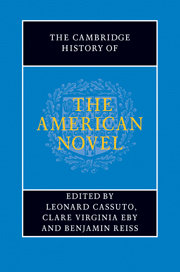Book contents
- Frontmatter
- General Introduction
- PART ONE INVENTING THE AMERICAN NOVEL
- PART TWO REALISM, PROTEST, ACCOMMODATION
- PART THREE MODERNISM AND BEYOND
- Introduction: modernism and beyond
- 37 Stein, Hemingway, and American modernisms
- 38 The Great Gatsby and the 1920s
- 39 Philosophy and the American novel
- 40 Steinbeck and the proletarian novel
- 41 The novel, mass culture, mass media
- 42 Wright, Hurston, and the direction of the African American novel
- 43 Ellison and Baldwin: aesthetics, activism, and the social order
- 44 Religion and the twentieth-century American novel
- 45 Faulkner and the Southern novel
- 46 Law and the American novel
- 47 Twentieth-century publishing and the rise of the paperback
- 48 The novel of crime, mystery, and suspense
- 49 US novels and US wars
- 50 Science fiction
- 51 Female genre fiction in the twentieth century
- 52 Children's novels
- 53 The American novel and the rise of the suburbs
- 54 The Jewish great American novel
- 55 The Beats and the 1960s
- 56 Literary feminisms
- 57 Reimagining genders and sexualities
- PART FOUR CONTEMPORARY FORMATIONS
- A selected bibliography
- Index
51 - Female genre fiction in the twentieth century
from PART THREE - MODERNISM AND BEYOND
Published online by Cambridge University Press: 28 July 2011
- Frontmatter
- General Introduction
- PART ONE INVENTING THE AMERICAN NOVEL
- PART TWO REALISM, PROTEST, ACCOMMODATION
- PART THREE MODERNISM AND BEYOND
- Introduction: modernism and beyond
- 37 Stein, Hemingway, and American modernisms
- 38 The Great Gatsby and the 1920s
- 39 Philosophy and the American novel
- 40 Steinbeck and the proletarian novel
- 41 The novel, mass culture, mass media
- 42 Wright, Hurston, and the direction of the African American novel
- 43 Ellison and Baldwin: aesthetics, activism, and the social order
- 44 Religion and the twentieth-century American novel
- 45 Faulkner and the Southern novel
- 46 Law and the American novel
- 47 Twentieth-century publishing and the rise of the paperback
- 48 The novel of crime, mystery, and suspense
- 49 US novels and US wars
- 50 Science fiction
- 51 Female genre fiction in the twentieth century
- 52 Children's novels
- 53 The American novel and the rise of the suburbs
- 54 The Jewish great American novel
- 55 The Beats and the 1960s
- 56 Literary feminisms
- 57 Reimagining genders and sexualities
- PART FOUR CONTEMPORARY FORMATIONS
- A selected bibliography
- Index
Summary
American women write and read all of the genres that constitute “genre fiction”: the mystery, detective fiction, science fiction and fantasy, the Western, horror fiction, thrillers, spy fiction, and romance novels. The romance is the most gendered of all these genres – it is the female genre, both written and read largely by women. The romance novel is also the most popular of these genres. In 1999, for example, more than 2,500 romances were published in North America, accounting for 55.9 percent of mass market and trade paperbacks sold. In the twentieth century alone, thousands of American authors wrote and published tens of thousands of romance novels. In 2007, the latest year for which there are data, the number of romance titles published in North America had risen to 8,090.
In the last three decades of the twentieth century market forces coalesced that would lead to this remarkable output, and that would make romance novels the dominant form of American fiction. By 1971 Harlequin Books, founded in Canada in 1949 as a paperback reprint publisher, had devised an extensive, efficient distribution system for their romances, written almost wholly by British and Commonwealth authors, as well as by their single American author, Janet Dailey. Throughout the 1970s, Harlequin dominated the American romance market for short contemporary romances (so-called “category” romances). In 1980, American publisher Simon & Schuster entered this market by creating Silhouette Books, whose editors tapped the backlog of manuscripts by American writers rejected by Harlequin, most notably, Nora Roberts (about whom more later).
- Type
- Chapter
- Information
- The Cambridge History of the American Novel , pp. 847 - 860Publisher: Cambridge University PressPrint publication year: 2011



